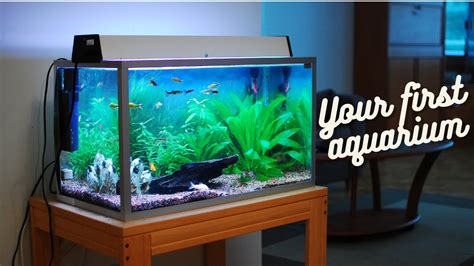Setting up and cycling an aquarium is crucial for the health and longevity of your aquatic inhabitants. This process involves creating a stable and biologically active environment that supports a thriving ecosystem.

Aquarium Setup: Choosing the Right Components
Tank Size and Shape: The size and shape of your tank will depend on the species and number of fish you plan to house. Larger tanks generally provide more stability and space for swimming.
Filtration: A reliable filtration system is essential for removing waste and maintaining water quality. Choose a filter that is rated for the size of your tank and consider the specific needs of your fish.
Heater: Most tropical fish require a heater to maintain an optimal temperature. Choose a heater that is appropriate for the tank size and has adjustable settings.
Substrate: The substrate is the material that covers the bottom of the tank. It provides a substrate for beneficial bacteria and can help to buffer water pH.
Lighting: Proper lighting is essential for plant growth and fish activity. Use a light that is designed for aquarium use and adjust the lighting schedule to suit the needs of your fish.
Cycling: Establishing a Biological Ecosystem
Nitrification: Cycling involves establishing a colony of beneficial bacteria that convert toxic ammonia and nitrites into less harmful nitrates. This process takes time and patience.
Fishless Cycling: In fishless cycling, you add an ammonia source (such as pure ammonia or shrimp pellets) to the tank without fish. The beneficial bacteria will colonize and establish themselves in the filter media and substrate.
Fish-in Cycling: In fish-in cycling, you add fish to the tank while the nitrogen cycle is still establishing. This method requires more frequent water changes and close monitoring to ensure that ammonia and nitrite levels do not become toxic to the fish.
Benefits of Cycling: Why It Matters
Improved Water Quality: Cycling helps to eliminate toxic ammonia and nitrites, improving the overall health of your fish.
Reduced Algae Growth: Beneficial bacteria consume nutrients that would otherwise be used by algae, reducing algae growth and keeping your tank cleaner.
Increased Fish Survival: A cycled tank provides a stable and healthy environment for your fish, increasing their survival rate and longevity.
Tips and Tricks
- Test Your Water Regularly: Use a water testing kit to monitor ammonia, nitrite, and nitrate levels regularly.
- Do Partial Water Changes: Change 10-25% of the tank water weekly to remove nitrates and replenish minerals.
- Feed Your Fish Appropriately: Overfeeding can overload the filter and create excess waste, hindering the cycling process.
- Avoid Overstocking: Don’t add too many fish to your tank at once. Allow the cycling process to establish before introducing new fish.
FAQs
How long does it take to cycle an aquarium? The time it takes to cycle an aquarium depends on the method used. Fishless cycling can take 4-8 weeks, while fish-in cycling may take 6-12 weeks or longer.
What are the symptoms of an uncycled aquarium? Symptoms include high ammonia and nitrite levels, cloudy water, and fish exhibiting stress or illness.
Can I use tap water in my aquarium? Tap water contains chlorine and chloramine, which can be harmful to fish. Use a water conditioner to neutralize these chemicals before adding tap water to your tank.
How often should I clean my filter? Clean your filter media every 2-4 weeks or as needed to prevent clogging and maintain water quality.
Expanding Market Insights
The aquarium market is expected to grow significantly in the coming years. Factors such as rising disposable income, increasing pet ownership, and the growing popularity of aquascaping are driving this growth. The demand for high-quality aquarium equipment, including filtration systems, lighting, and substrates, is expected to increase.
Case Detail: Comparing Fishless vs. Fish-in Cycling
Fishless Cycling:
- Advantages: No need to purchase or care for fish during the cycling process.
- Disadvantages: Longer time to establish the nitrogen cycle.
Fish-in Cycling:
- Advantages: Less waiting time to add fish.
- Disadvantages: Higher risk of fish stress and mortality. Requires more frequent water changes and close monitoring.
Table 1: Aquarium Size Recommendations by Fish Type
| Fish Type | Recommended Tank Size (Gallons) |
|---|---|
| Betta | 5-10 |
| Guppies | 10-20 |
| Tetras | 15-30 |
| Angelfish | 50-100 |
| Discus | 75-100 |
Table 2: Filtration System Types and Features
| Filtration Type | Features |
|---|---|
| Mechanical | Removes solid waste particles |
| Biological | Hosts beneficial bacteria that break down waste |
| Chemical | Uses activated carbon or resin to remove impurities |
| Undergravel | Promotes oxygenation and bacterial growth |
| Canister | Compact and efficient, provides high filtration capacity |
Table 3: Substrate Options for Aquariums
| Substrate Type | Benefits |
|---|---|
| Gravel | Inexpensive, provides good support for plants |
| Sand | Fine-grained, ideal for bottom-dwelling fish |
| Soil | Nutrient-rich, supports plant growth |
| Aquascaping Stones | Decorative and provides hiding places |
| Live Plants | Remove nitrates and provide shelter |
Table 4: Water Testing Parameters and Ideal Values
| Parameter | Ideal Value |
|---|---|
| pH | 6.5-8.0 |
| Ammonia | 0 ppm |
| Nitrite | 0 ppm |
| Nitrate | <20 ppm |
| Dissolved Oxygen | 5-8 ppm |
| Temperature | Specific to the fish species |





















